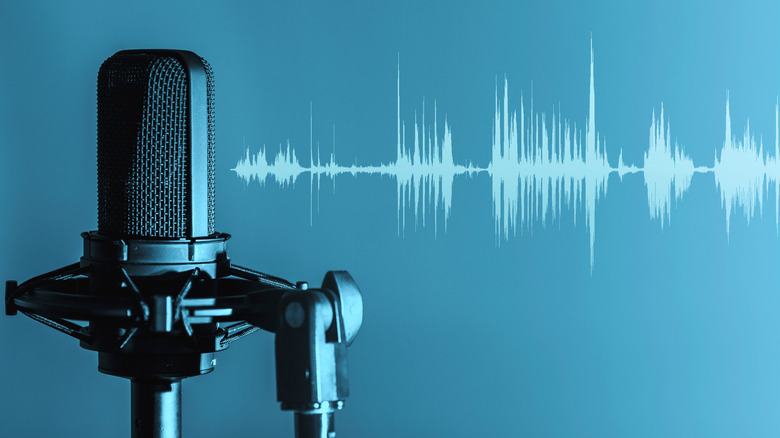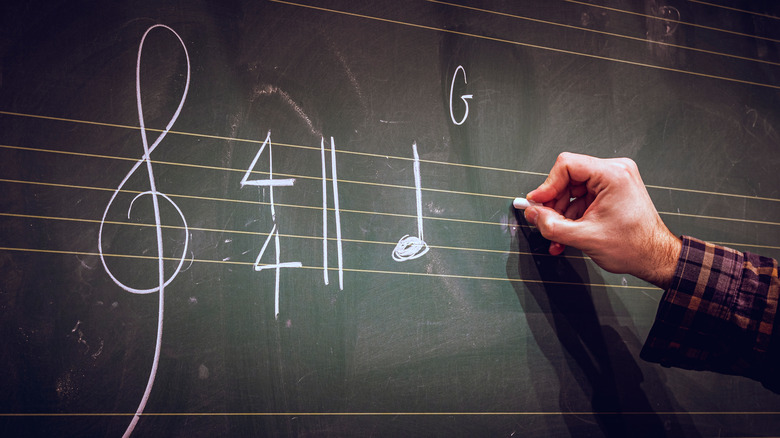The Musical Abilities Of Perfect Pitch And Relative Pitch Explained
Those who've studied music theory know how much of a challenge it can be. Circles of fifths, major sevenths, secondary dominants, even simpler terms like intervals, semitones, or triads: such inflated verbiage can sound utterly alien and intimidating. Without training, they seem to have no connection to your inner, emotional world as it experiences a favorite song. Add to this a general belief, or vain hope, that musical abilities are "gifts" or "talents" (thanks, "American Idol") rather than inclination mixed with hard work, and you've got a recipe for college freshmen treating anything but "Music Appreciation" classes like the plague.
Some folks, though, really were seemingly born with "an ear" for music, melody, and songcraft. David Bowie, Paul McCartney, Dolly Parton: would anyone deny the innate abilities of such few, rare, admittedly mythologized names? What about jazz wizards like Thelonious Monk or Miles Davis? Or historical legends like Wolfgang Amadeus Mozart? Did any of these people have to study music, or did it all just come naturally?
Well, as with most things, the answer lies in the nuanced middle. As any creative — and also productive — person will tell you: "waiting for inspiration" is the most surefire way to fail. "Creativity" isn't an attribute, it's an action. Even Mozart, contrary to what the movie "Amadeus" tells us, sketched and drafted endlessly, as Invision explains. Music is, frankly, hard work.
This is where the "perfect pitch" and "relative pitch" discussion comes into play, at the intersection of talent and labor.
Recognizing the frequency of a single tone
Some folks can hum along to a tune the first time they hear it. Or maybe they can predict how a song is going to progress: the melody as it shifts to the pre-chorus, the chorus as it revs down into the second verse, etc. That kind of musical knack relies on hearing the distance, or difference, between notes — the "interval," as musicians might say. In other words, melody depends on context: what notes come first, and what notes we expect to come after. Notes can go higher, like Sia singing the chorus of "Chandelier" (an impossible karaoke task), or lower.
If we want to describe notes in a way that doesn't require sound — useful for recording music on paper, without modern audio equipment — we give them names, conveniently based on familiar letters, like A# (A sharp) or Eb (E flat). A note with a name is called a "tone." Every eighth tone, going up or going down, repeats; this is called a "scale." You know: Do Re Mi Fa So La Ti Do? The first and last "Do" are the same tone, but different notes - the first one is lower, the second one is higher.
But what is a "tone," exactly? It's a frequency, because all sounds are waves. And some folks can recognize the frequency of a single tone only by hearing it. Pluck a string? F#. This is called "perfect pitch."
Recognizing the difference between two tones
Perfect pitch, then, is like recognizing the flavor in a drink. How do you know a craft beer has grapefruit "notes"? You've eaten at least one grapefruit and can recognize the flavor. And so, perfect pitch requires some exposure to grapefruits (as this analogy goes), to know a grapefruit from a kiwi. Perfect pitch people, minimally, have to know the names of frequencies: A, B, C, D, etc.
By all indications, this ability seems to be inborn, as Earmaster states. This shouldn't rattle anyone too much, though: some folks are short, some are athletic, some need glasses, some can't tell the difference between teal and cyan, some snore in their sleep, some have "green thumbs," and some are terrible at directions. It especially doesn't mean that everyone who has perfect pitch will be the next John Lennon. Like any aptitude, without early childhood encouragement, musical training, or years of practice playing an instrument or singing, perfect pitch probably just means that someone has a nice, possibly irksome party trick to brag about.
But even though perfect pitch can't be "learned," with enough practice someone can still tell the name of a tone on the spot. Musicians who've played for years, like any expert, have grown so accustomed to composition, musical scales, chord progressions, etc., that they might be able to recognize "F!" or "C#!" directly from memory, in the same way that someone sees the sun and says "yellow!" This is "relative pitch."
A world of colorful, emotional sights and sounds
Relative pitch, then, is called "relative" because it requires a comparison between two or more tones to be able to name one of them, per Classic FM. Going back to the "grapefruit beer" example, part of the way you recognize a grapefruit flavor is by eliminating other flavors. A grapefruit isn't an apple, orange, banana, etc. The sun is "yellow," logically, because it isn't blue, purple, green, and so forth. Dark requires light, big requires small, high requires low — most descriptions invoke innate comparisons. And so, a "C" tone is easier to spot if you know its neighbors: B and D.
People with perfect pitch, though, don't need that comparison to recognize a frequency. Such people, in fact, tend to find it difficult to describe how they know a tone only by hearing it. Oftentimes, they'll use comparisons that sound like experiences of synesthesia, a neurological condition where people "see" sounds, "hear" colors, or "smell" textures, as explained on Healthline. Many such explanations of perfect pitch utilize non-musical terminology and unusual analogies.
On Quora, for example, a bunch of people with perfect pitch describe how they recognize tones. One person says that "A" is "Open. Aristocratic. Wine." "D" is a "wandering traveler who lives in the moment." "Db (D flat)" is [S]pring green. Still mellow, but has hints of excitement." Such explanations might sound kooky, but folks do the same with colors. Red, for example, is "passionate," or yellow is "cheerful."
Neurological differences in perfect pitch brains
As for how perfect pitch (sometimes called "absolute pitch") develops, we leave that to the hands of neurologists and other such researchers, who are among the only ones daring enough to attempt to demystify such seeming magic.
Predictably, there definitely seems to be structural, organ-level, possibly genetically derived, differences in brains between those who have perfect pitch and those who don't. The Journal of Neuroscience describes people with perfect pitch as having "significantly larger volume" of auditory cortices (the part of the brain responsible for processing sound in the temporal lobe), leading them to be able to "encode and identify frequency." Another study in Current Neurology and Neuroscience Reports attempted to locate the "pitch center" of the brain, where frequencies are processed, and settled on the superior temporal gyrus (a ridge on the, again, temporal lobe). Yet another study in the Psychology of Music identified children who have a "more analytical cognitive style" and were exposed to musical training before the ages of 5-7 as being more likely to develop perfect pitch. That study also, interestingly, found a potential relationship between perfect pitch and autism.
For those doomed to forever wander the discordant muck of relative pitch (kidding): it takes a lot of time, skill, and effort to get there. Everyone else with varying degrees of musical aptitude, screeching voices, tone deafness, or whatever in between, can still flip on Spotify and be no less enriched by their cherished music.




